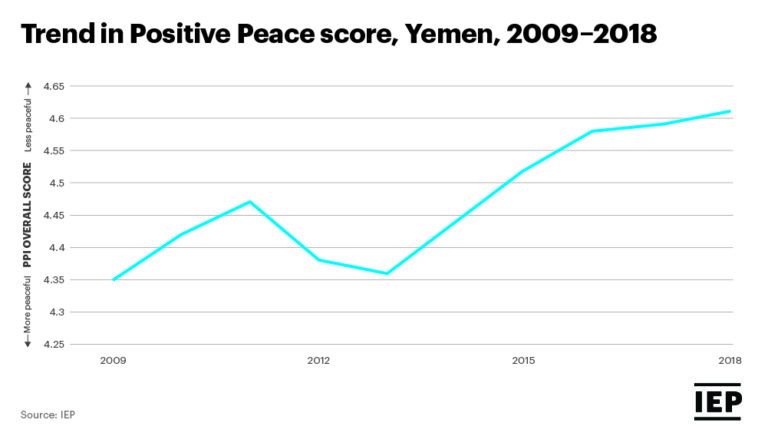 The COVID-19 pandemic will intensify the impacts of ongoing conflict and ecological threats in Yemen.
The COVID-19 pandemic will intensify the impacts of ongoing conflict and ecological threats in Yemen.
Yemen is considered an ecological hotspot, facing high exposure to all three resource depletion indicators measured in the Ecological Threat Register (ETR) – water stress, food security and population growth – and with low resilience to respond to such threats.
Since 2015, ongoing conflict in Yemen has led to what the United Nations (UN) describes as the “worst humanitarian crisis in the world.” Armed conflict has resulted in the displacement of millions, caused a deep economic crisis and led to a widespread food insecurity crisis. More than 80% of the country’s population is at risk of hunger and disease. The COVID-19 pandemic is set to exacerbate the humanitarian crisis, with some estimates predicting 17 million people are in need of humanitarian assistance. This represents the largest food insecure population in the world.
Prior to the civil war, Yemen was primarily dependent on food imports with only around 25% of food being produced domestically. Food affordability is a critical concern to households, as pre-existing global food price increases and currency depreciation interact with COVID-19 related trade restrictions. Remittances, which play a critical role in the economy, have been substantially reduced and other income is expected to decline further as COVID-19 disruptions affect businesses.
Yemen’s health care system was already under stress prior to the pandemic, following years of conflict and outbreaks of communicable diseases, such as cholera. Many healthcare facilities have been destroyed by airstrikes and shelling, with the country also facing a shortage of healthcare workers. With the onset of the COVID-19 pandemic, the rise in case numbers and limited supply of medical equipment has led to the effective collapse of Yemen’s health care system.
The ongoing civil war fought between the Saudi-backed Yemeni government and Houthi armed movement, along with their allies, has meant that no central government is in charge, making the COVID-19 pandemic much harder to contain. This has created significant challenges for aid organizations to understand the level of disease transmission and prepare accordingly as reporting on case numbers vary widely between government and rebel-held areas.
Heavy rains and intense floods have also disrupted access to health and sanitation services, and created ideal conditions for the spread of water-borne diseases, like cholera and dengue fever. In 2019, the UN estimated that approximately 19.7 million people lacked access to adequate health care.[ix]
Collectively, ongoing conflict and recurring ecological threats have led to widespread displacement across Yemen. Since 2015, over 3.4 million new displacements were recorded as a result of conflict, while disasters, mainly floods, resulted in 177,000 new displacements.
Related Articles: Why the Yemen Humanitarian Crisis Matters | Yemen’s Ongoing Conflict | COVID-19 and Conflict: Is Peace the Cure?
Positive Peace in Yemen
Using IEP’s Positive Peace Index (PPI), the ETR analyses the relationship between countries with high ecological threats and low levels of resilience to identify ecological “hotspots”, or countries most at risk from resilience breakdown. Yemen ranks among the world’s least resilient countries, ranking 162nd out of 163 countries in the 2019 PPI. Yemen is considered most vulnerable to the impacts of ecological threats, including deteriorations in civil unrest, political instability, social fragmentation and economic collapse.
The figure below illustrates the significant decline in Yemen’s Positive Peace since 2013, which has worsened as a result of prolonged conflict.
Like in Yemen, the COVID-19 pandemic has also had a triple-negative impact on other fragile nations. Firstly, the pandemic caused a large number of fatalities and stretched already precarious health systems. Secondly, the global recession reduced household incomes through decreased investment and trade. And lastly, the severe economic contraction expected for advanced economies in 2020 will most likely curtail the foreign aid flows fragile countries need to preserve social stability.
With very low and deteriorating levels of Positive Peace, Yemen will face significant challenges in tackling ecological threats and the COVID-19 pandemic. Without assistance from the international community, the COVID-19 pandemic will only intensify Yemen’s suffering and leave the country unable to cope with recurring ecological threats in the future.
This article was written by IEP Research Fellow Olivia Adams, a Research Fellow at the Institute for Economics and Peace based in Sydney, Australia.
EDITOR’S NOTE: The opinions expressed here by Impakter.com columnists are their own, not those of Impakter.com.
In the Photo: Food aid sent by the World Food Program (WFP) is being distributed to needy people in Yemeni capital city Sanaa on 3 June 2020. Photo Credit: Mohammed Hamoud/Anadolu Agency










